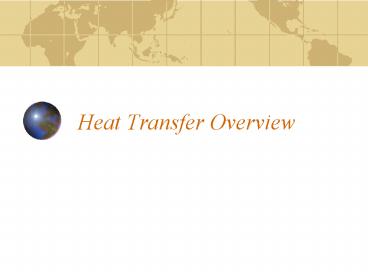Heat Transfer Overview - PowerPoint PPT Presentation
1 / 18
Title:
Heat Transfer Overview
Description:
Heat Transfer Overview How Do We Define Heat Transfer? Energy in transit due to a temperature difference Electrical analogy Concerned with time rate of change In this ... – PowerPoint PPT presentation
Number of Views:113
Avg rating:3.0/5.0
Title: Heat Transfer Overview
1
Heat Transfer Overview
2
How Do We Define Heat Transfer?
- Energy in transit due to a temperature difference
- Electrical analogy
- Concerned with time rate of change
- In this well calculate things such as
- What rate of heat transfer will occur in a
certain situation? - What temperatures can we expect?
- How long will it take to heat/cool something?
- What are some specific applications?
3
Examples of Where You May Use Heat Transfer in
Industry
- Estimating the temperature of components on a
circuit board to determine if failure rates are
acceptable and then designing the cooling system - Choosing a heat sink and fan that will cool a
transistor appropriately - Determining the orientation and size of solar
panels needed to power a micro-satellite - Designing the cooling system for an ice-hockey
table - Choosing the type and size of heat exchanger to
be used to heat a chemical used in semi-conductor
manufacturing
4
More Examples
- Choosing the type and size of radiator needed for
a new type of automobile - Calculating the optimal amount of insulation to
be placed on a steam pipe to reduce heating costs - Determining how much power must be applied to an
antennae on an airplane to keep water from
freezing on it - Designing a quick-freezing system for a meat
distributor to seal in flavor and juices - Calculating heat losses and gains from a building
to size their heating and air conditioning systems
5
Types of Heat Transfer
- Conduction due to interaction between particles
usually through a solid - Convection gas to solid (or vice versa)
- Includes both conduction between particles and
advection (heat transfer due to mixing) - Radiation radiated energy (no medium needed)
6
Why not just use computer programs? Why take a
class?
- How will you set up the model? What boundary and
initial conditions? - Are the simplifications chosen OK?
- 3-D convection at moderate/high velocities is
impossible to solve without significant
simplifications - How will you interpret the results? Are the
results accurate?
7
Conduction
- Energy transfer from more to less energetic
particles due to particle interactions
diffusion of energy due to molecular activity - Examples
- Usually involves solids
- Rate f(
) - What is the driving potential?
8
Fouriers Law of Heat Conduction
kthermal conductivity (W/mC or Btu/h ft F) --
a measure of how fast heat flows through a
material -- k(T), but we usually use the value
at the average temperature q can have x, y,
and z components its a vector quantity
9
Special Case
- If T(x) is linear, Fouriers Law for the 1-D case
becomes - When will this happen?
- Example
10
Conduction Definitions
- Heat capacity rcp (J/m3C)
- Amount of heat needed to raise a unit volume of
material one degree - Thermal diffusivity a k/rcp (m2/s)
- How fast heat diffuses through a material
11
Convection
- Energy transfer due to both
- molecular motion (diffusion, like conduction) and
- bulk motion of fluid (motion of gas or liquid)
- Advection
- Convectiondiffusionadvection
- Three kinds
- Forced convection external fluid motion
- Natural (free) convection motion due to
buoyancy effects - Latent heat exchange due to phase change
condensation, boiling (covered in ME 211 but not
ME 114)
12
Newtons Law of Cooling
- hheat transfer coefficient (W/m2C)
- Tssolid surface temperature
- T temperature of fluid far from surface
- hf(
)
13
Boundary Layer
14
Example
- A 0.4 cm x 2 cm computer chip must dissipate 5 W
of heat. Air with a heat transfer coefficient of
80 W/m2K and a temperature of 20C blows over
the chip. The chip is in danger of overheating if
it reaches 90C. Is the chip in danger? Should
you attach a heat sink?
15
Thermal Radiation
- Emitted by all matter above 0 Kelvin
- Due to changes in electron configurations
- Requires no medium
- Emissive power of a blackbody (ideal radiator)
- Tssurface temp in Kelvin
- sStefan-Boltzmann Constant 5.67x10-8 W/m2K4
16
Thermal Radiation, Cont.
- eemissivity how efficiently a surface emits
compared to a blackbody - aabsorptivity percent of incident flux absorbed
- e,a f(temp, wavelength, surface condition)
17
Thermal Radiation, cont.
- Special case ea if surface temperatures of all
surfaces in an enclosure are close - Special case surface completely surrounded by
another isothermal surface, no intervening medium
18
Total Heat Transfer
- Only conduction, convection, or radiation can
occur or else a combination can occur
simultaneously - QconvQrad or QcondQrad































